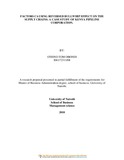| dc.description.abstract | Effective supply chain management should eliminate variabilities in stocks at end sale points and supply points. Companies are trying to reduce these variabilities by employing different operations strategies to match demand forecasts with production. Success has been varied as this variability continues with shifting manifestations, at one point the variability is upstream and at the other point, the variability is downstream in the supply chain. This poses multiple challenges on the supply chain strategy. Variability of demand upstream has been described as bullwhip effect (Fransoo and Wouters, 2009), while variability of supply downstream is what has been described as reversed bullwhip effect (Svenson, 2003). While demand variability throughout the supply chain has received considerable attention in the literature, supply variability in the middle of a supply chain has not been adequately addressed in available literature.
The study sought to establish the underlying causes of middle chain supply variability i.e. reversed bull whip effect between KPC the supplier and the oil marketers; the wholesalers. The objective of the study was to find out the causes of supply variability on supply chain of KPC. The study narrowed down to supply chain structures, information flow, capacity challenges and effect of government regulation and customer business procedures as the principle causes. These perceived causes of supply variability were formulated into research questions which the study sought to answer. Case study was used and data for operations for the last two years was gathered through questionnaire. Purposive sampling was employed. From the population of seven (7) depots a sample of five (5) depots had been chosen for the study.
The response rate was 100%. Data analysis was done using the social science statistical package of SPSS. The findings showed that capacity constraints are the main cause of supply variation along the supply chain of KPC. It was discovered that while storage capacity down stream is sufficient, the upstream availability of the product was not sufficient because of the pipeline network. All the respondents agreed that the government intervention through KRA delayed order processing since it created another layer within the supply chain. It was also discovered that extending the loading hours can improve the capacity constraints but security issue was a major scare. However the business procedures of oil marketers, the supply chain structure ofKPC and the extent of business information flow had very little effect on the varaibilities of supply along the supply chain of KPC.
This implied that product and information movement routes had no meaningful impact on the speed of the product being transported. It is only the efficiency of the supply source that determined the variability at the end sale points. The demand for the services ofKPC is projected to continue on the upward trend. Given the ever increasing demand for these services, capacity enhancement strategies like more time, parallel supportive pipeline network, lean supply chain structures and reliable equipment need to be installed to eliminate the supply variation at points of sale. This study was limited to non value addition outbound logistics of the supply chain. There is need to also consider value addition within the supply chain to address the impacts of refining, storage allocation to customers from the down stream inventory facilities of the supply chain. | en_US |

